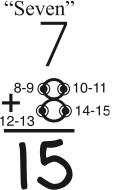

Remarks: Always beginning with the top or first number instead of the bigger number in figuring an addition fact avoids problems with subtraction. A common error in subtraction is for students to always subtract the smaller number from the larger number, even in problems requiring regrouping. For a problem like 65 – 27, students committing this error will subtract 5 from 7 and get 42 instead of 7 from 15 to get 38. Students taught to always start with the top number and work down for the addition facts are more likely to always start with the top number and work down for subtraction where it's required, not a choice. Students who prefer to start with the bigger number for the addition facts because it promotes a quicker result, either because they were taught to do so in an earlier grade or began the practice on their own, should be allowed to continue to do so, but they should be cautioned to always start with the top or first number for subtraction.
Counting on is valuable preparation for the “counting up to” model for subtraction. For example, 13 – 8 may be worked by saying “eight” and counting 9-10-11-12-13 while keeping track of the number of counts, five in this case. This way of viewing subtraction is regarded by some researchers (Fuson 1984; Fuson and Secada 1986; Fuson and Willis 1988) as a much-needed supplement to the standard approach of teaching only the take-away model for subtraction.
The counting up to model is sometimes called shopkeeper’s math because of its use in making change. For example, if a $7 purchase is made with a $10 bill, a shopkeeper might count 8-9-10 to check their arithmetic for how much change to return. Before cash registers did the arithmetic for shopkeepers, almost all of them returned change this way!
Tap & Tally™ Lessons 41-48

Figuring Out the Addition Facts Fast (Counting On)
Prerequisites: The Tap & Tally™ numerals and knowing how to count on, that is, being able to start with any number between 1 and 9 and count to 18 (for example, to start with 5 and count 6-7-8- . . . -18). Elementary school students who have difficulty with counting on should be allowed to continue to count all the tap points.
Procedure: Say the top or first number and count from there on the tap points of the bottom or second number. The last number said is the answer.
For 5 + 4, say “five” and count 6-7-8-9, with 9 being the answer.
For 7 + 8, say “seven” and count 8-9, 10-11, 12-13, 14-15, with 15 being the answer.
Mad Minute Primer